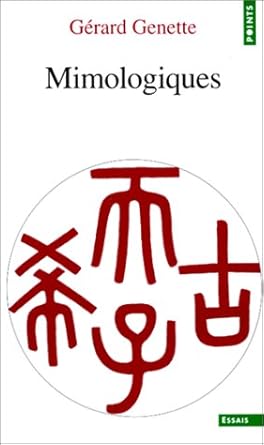This is only a brief outline, since the text is very rich and no summary can do it justice. I can only give some reading impressions, but my recommendation is enthusiastic. I read the French original: an English version was published in 1995 under the title Mimologics (see a brief review and a second one.) I haven't read the English text so I cannot comment on the quality of the translation (by Thaïs E. Morgan), but it must have required a huge effort, due to the subject matter but also to the particular style (Genette is not above playing the Cratylian game himself).
This is part I in a series. See also part II, part III or part IV.
Cratylism
Genette's question is (at least) as old as Plato's Cratylus: what is the relation between words and the objects they designate? Is it purely conventional, or does it contain an element of "reflective analogy"? In Plato's dialogue these two positions are defended by Hermogenes and Cratylus, respectively, so the latter point of view came to be known as Cratylism, hence the book's subtitle Voyage in Cratylusland (as rendered by Morgan.)
Genette and Eco
I read this book in parallel with Umberto Eco's The Search for the Perfect Language, since the two topics are intimately related: to be "perfect" (in one of many senses: Adamic, hieroglyphic, onomatopoeic, practical, universal etc.), a language must use the "proper" term; this is the essence of the Cratylist position. Thus, the two works share many references (from Herodotus to Hjelmslev and from Wallis to Wilkins) but their point of view is completely different: where Eco gives a chronological, encyclopaedic and rather conventional overview, Genette is mostly topical, eclectic and quirky. This may be the reason Eco only cites Genette once, although conceptually the latter covers a lot of the same ground as the former (and then some).
Chapter 1 – Eponymy of the name (chapter titles in English from Morgan's translation)
This is part I in a series. See also part II, part III or part IV.
Cratylism
Genette's question is (at least) as old as Plato's Cratylus: what is the relation between words and the objects they designate? Is it purely conventional, or does it contain an element of "reflective analogy"? In Plato's dialogue these two positions are defended by Hermogenes and Cratylus, respectively, so the latter point of view came to be known as Cratylism, hence the book's subtitle Voyage in Cratylusland (as rendered by Morgan.)
Genette and Eco
I read this book in parallel with Umberto Eco's The Search for the Perfect Language, since the two topics are intimately related: to be "perfect" (in one of many senses: Adamic, hieroglyphic, onomatopoeic, practical, universal etc.), a language must use the "proper" term; this is the essence of the Cratylist position. Thus, the two works share many references (from Herodotus to Hjelmslev and from Wallis to Wilkins) but their point of view is completely different: where Eco gives a chronological, encyclopaedic and rather conventional overview, Genette is mostly topical, eclectic and quirky. This may be the reason Eco only cites Genette once, although conceptually the latter covers a lot of the same ground as the former (and then some).
Chapter 1 – Eponymy of the name (chapter titles in English from Morgan's translation)
- Not surprisingly, the voyage starts with a discussion of Plato's dialogue and introduces some key concepts. For Genette, Socrates adopts an original position, of frustrated Cratylism (or secondary mimologism): it is legitimate to search for a correspondence between words and objects, but names in current use may very well have been ill-chosen (e.g. sklerotes); the name-giver is not infallible.
- The adequacy of names to objects has two origins: for composite and derivative names it resides in eponymy, i.e. the correspondence of sense and signification. For instance, the name "Hermogenes" (with its implication of affluence) is not suited for the man Hermogenes (who is poor). This criterion cannot apply to simple names, whose correctness is defined in terms of vocal mimesis: words containing r denote motion, l is a sign of smoothness etc.
Chapter 2 – De ratione verborum
- Illustrates the articulation of the two kinds of justification: (etymological -by eponymy- and mimetic) for word-object correspondence by a few examples from the antiquity, insisting on St. Augustine's De dialectica, which Genette sees as some sort of continuation to the Cratylus.
Chapter 3 – Soni rerum indices
- For John Wallis, the English language is the (only) perfect one, somewhat at odds with the Cratylist thesis. His interpretation is quite elaborate, taking into account the position of the letters in the word.
Chapter 4 – Hermogenes, the Master of Words
- The debate between Locke and Leibniz is similar to that opposing Hermogenes and Cratylus, but Leibniz's position is less extreme: he admits the existence of conventional (artificial) languages, Chinese among them (according to Golius). Other examples are the invented languages of Dalgarno and Wilkins.
- Categorizing Chinese as an artificial language highlights two diametrically opposed interpretations of non-phonetic writing systems: the ideogram (seen as purely conventional) and the hieroglyph (purely mimetic).
- Three sentences can serve as landmarks on the continuum between absolutely mimological (Cratylus) and absolutely conventional (e.g. Saussure):
language must be/can be/is mimetic.
Socrates, Leibniz and Hermogenes would then be somewhere in-between, as they might accept some (but not all) of the above.

No comments:
Post a Comment